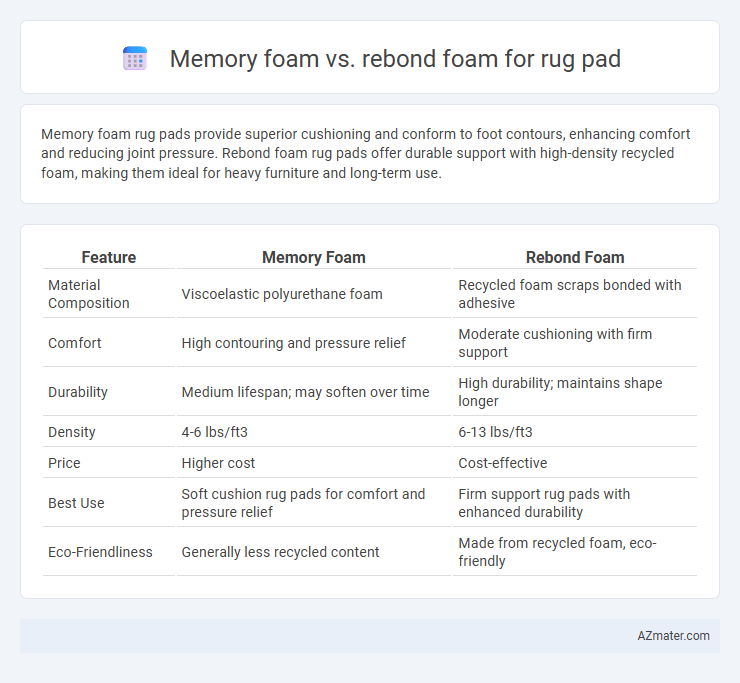Memory foam rug pads provide superior cushioning and conform to foot contours, enhancing comfort and reducing joint pressure. Rebond foam rug pads offer durable support with high-density recycled foam, making them ideal for heavy furniture and long-term use.
Table of Comparison
| Feature | Memory Foam | Rebond Foam |
|---|---|---|
| Material Composition | Viscoelastic polyurethane foam | Recycled foam scraps bonded with adhesive |
| Comfort | High contouring and pressure relief | Moderate cushioning with firm support |
| Durability | Medium lifespan; may soften over time | High durability; maintains shape longer |
| Density | 4-6 lbs/ft3 | 6-13 lbs/ft3 |
| Price | Higher cost | Cost-effective |
| Best Use | Soft cushion rug pads for comfort and pressure relief | Firm support rug pads with enhanced durability |
| Eco-Friendliness | Generally less recycled content | Made from recycled foam, eco-friendly |
Introduction: Choosing the Right Rug Pad
Memory foam rug pads offer excellent cushioning and pressure relief, making them ideal for high-traffic areas or spaces requiring extra comfort. Rebond foam rug pads, composed of recycled foam pieces, provide superior durability and firm support while being eco-friendly. Selecting between memory foam and rebond foam depends on balancing comfort preferences with long-lasting performance for your specific living space.
What is Memory Foam?
Memory foam is a viscoelastic polyurethane material known for its slow response to pressure, contouring closely to the shape of objects and providing superior cushioning and support. It is commonly used in rug pads for its ability to absorb impact, reduce floor noise, and prevent slipping, while maintaining durability under foot traffic. Compared to rebond foam, memory foam offers better pressure distribution and enhanced comfort but may have a higher cost and slightly less firmness.
What is Rebond Foam?
Rebond foam, commonly used in rug pads, is made from shredded scrap foam pieces bonded together using adhesive and heat, creating a dense, durable material that offers excellent cushioning and support. It provides superior resilience and shock absorption compared to memory foam, making it ideal for high-traffic areas and heavy rugs. The firm structure of rebond foam enhances rug stability and floor protection by preventing slipping and reducing wear.
Comfort and Cushioning Comparison
Memory foam rug pads provide superior comfort by conforming closely to the shape of feet and furniture, offering pressure relief and enhanced cushioning. Rebond foam rug pads deliver firm support with a denser, more resilient structure that maintains shape over time but may feel less adaptive underfoot. For cushioning, memory foam excels in softness and contouring, while rebond foam prioritizes durability and consistent support.
Durability and Lifespan
Memory foam rug pads typically offer superior cushioning but tend to compress faster under heavy use, resulting in a shorter lifespan of around 3 to 5 years. Rebond foam, made from recycled foam scraps bonded together, is notably more durable and resilient, often lasting 7 to 10 years while maintaining its firmness and support. Choosing rebond foam enhances longevity and reliability for high-traffic areas in comparison to memory foam's softer but less durable properties.
Support and Stability Under Rugs
Memory foam rug pads offer superior cushioning and conform closely to the rug and floor, providing enhanced support by absorbing impact and reducing wear. Rebond foam, made from recycled foam pieces compressed together, delivers firmer stability and resists compression over time, maintaining consistent support beneath heavy rugs. Choosing between memory foam and rebond foam depends on balancing comfort with long-term durability and stability under various rug types.
Noise Reduction Capabilities
Memory foam rug pads excel in noise reduction due to their dense, viscous structure that absorbs and dampens sound waves effectively, making them ideal for quiet living spaces. Rebond foam, composed of shredded foam pieces bonded together, offers moderate noise reduction but tends to be less effective in isolating sound compared to memory foam. Choosing memory foam rug pads enhances acoustic comfort by minimizing footstep noise and impact sounds in high-traffic areas.
Safety and Non-Slip Properties
Memory foam rug pads offer excellent cushioning and conform closely to the rug and floor, enhancing comfort while providing moderate non-slip properties due to their dense structure. Rebond foam, made from recycled foam scraps, provides firm support and superior grip, significantly reducing rug movement and increasing safety by minimizing slip hazards. Both materials are typically treated for flame retardancy, but rebond foam often has higher durability and resilience against compression, contributing to lasting safety and non-slip performance.
Maintenance and Care Tips
Memory foam rug pads require gentle cleaning with mild detergent and spot treatment to maintain their cushioning and flexibility, avoiding excessive moisture that can lead to deterioration. Rebond foam pads, made from recycled foam scrap, benefit from regular vacuuming to remove debris and preventing prolonged dampness to avoid mold and odor buildup. Proper maintenance of either foam type extends durability and ensures effective support for area rugs.
Price and Value Analysis
Memory foam rug pads typically cost more than rebond foam options but offer superior cushioning and durability, making them a worthwhile investment for long-term comfort. Rebond foam is more budget-friendly while providing decent support and resilience, ideal for those seeking an economical solution without sacrificing basic protection. Evaluating price against longevity, memory foam delivers higher value in homes with heavy foot traffic, whereas rebond foam suits low to moderate use environments.

Infographic: Memory foam vs Rebond foam for Rug pad
 azmater.com
azmater.com